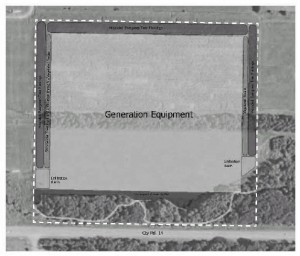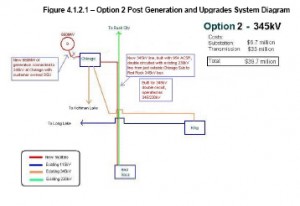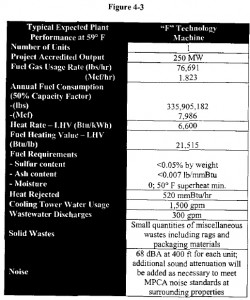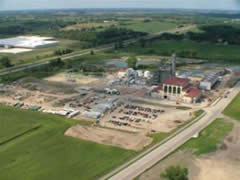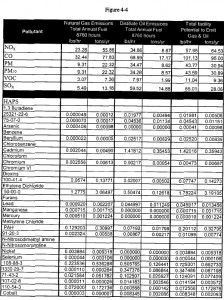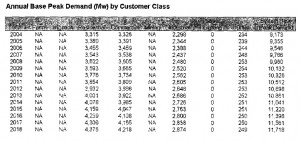500+ give LS Power a piece of their mind
October 20th, 2009
XCEL DOESN’T NEED OR WANT MORE ELECTRICITY, XCEL DOESN’T WANT A POWER PURCHASE AGREEMENT WITH LS POWER, SUNRISE ENERGY, OR WHOEVER…
That was the most important thing to come out of last night’s meeting. Mikey Bull was clear, stating in a most Norwegian way that “despite what Carol thinks, our load is growing,” and that they “won’t have a need… until 2016 or 2017.” I hope that people LISTENED CAREFULLY and were thinking critically.
Shellene Johnson, CRVC, walked Bob Cupit through the siting review and permitting options:
Bob was thrilled, I’m sure, he thought I’d put her up to it, but hey, I’m innocent — this is info that needs to be public, so that people understand all the options. Shellene had questions, particularly where this was an issue that had come up way back when we worked on the County Essential Services ordinance, and wanted to beef up the county’s ordinance to give them some options if a project went through local review. Local review is NOT a new issue for Chisago County, and if you recall, the SE Metro line went through the local review process.
Alan Muller was his usual delightful self, leading Blake Wheatley through a list of questions that demonstrated the “vaporware” nature of this project — he couldn’t or wouldn’t give us any information at all about the project. He knew NOTINK!
What would be the output of this plant? Answer:
780 MW summer rating. Over 800 winter rating. [Gas turbines
make more power when the air is colder and more dense.]How many generating units would there
be?
Answer: Don’t
know/haven’t decided.Who would be the manufacturer of the combustion
turbines? Answer:
Don’t know/haven’t decided.Who would be the manufacturer of the steam
turbines? Answer: Don’t
know/haven’t decided.How many smokestacks would the plant have?
Answer: Don’t know/haven’t
decided.How gallons or barrels of oil would be stored on the
site:
Answer: Don’t know/haven’t decided.How much oil would be burned in a
year?
Answer: Don’t
know/haven’t decided.In your air permit application, how many pounds per year of regulated air
pollutants would you be asking permission to put up your
smokestacks? Answer: Don’t know/haven’t
decided.And so on …..
…he knew nothing at all about this, and that’s because there’s nothing to know. There’s no project plan, no Power Purchase Agreement, no state permit applications, nada… This isn’t a project, it’s a farce… Tom Micheletti could take lessons from Blake Wheatley. Here’s the site plan, from the Oct 15 2009 Revised Draft Development Agreement:
WOW, that says a lot…
Take the time to read these:
Oct 15 2009 Revised Draft Development Agreement
I promised to post a few things so people can learn about prior proposals to get an idea what this one means, so let’s do that. Bear with me, this is interesting stuff!
This MISO Interconnection study says that for 660MW of generation at the Chisago sub, lots of transmission would need to be added. Here’s what one of the two similar options looks like (it’s better in print than here, looks hard to read):
Next is an answer to “what exactly are they proposing” with a couple of prior applications for gas plants as examples of what to expect, what to look for:
Faribault Energy Park – Application
These two applications are important to see what gas plants are all about. For example, the Faribault Energy Park is a 250MW plant, and here are some fun facts from the application:
A 250MW plant is 68 dB(A) 400 feet from the plant… what will a plant three+ times that be?
Here’s what that plant looks like – REMEMBER 750MW IS THREE TIMES THE SIZE OF A 250MW PLANT AND 855MW IS NEARLY FOUR TIMES AS LARGE:
Here’s a closer side view:
Here’s an emissions chart, and remember, the LS Power proposal is 3+ times this, so expect over three times the emissions:
And here’s a fun fact, from the 2004 Blue Lake application, showing their projected “need” back in 2004 that’s WAY overestimated:
From Xcel’s 2008 10-k, p. 10:
Capacity and Demand
Uninterrupted system peak demand for the NSP System’s electric utility for each of the last three years and the forecast for 2009, assuming normal weather, is listed below.System Peak Demand (in MW)
2006 2007 2008 2009 Forecast
9,859 9,427 8,697 9,662The peak demand for the NSP System typically occurs in the summer. The 2008 system peak demand for the NSP System occurred on July 29, 2008.
And now we know that instead of inexplicably going up in 2009, it’s going down. DOWN, further down. But note that in their 2008 10-k, Xcel admits that system peak was 8.697, lower than 2004. That pushes out any need until when? And the longer this drop continues, the further out and less probably any increased need is! And remember, Blue Lake was added to address the 11,000MW need claimed in the application. To get beyond that, how long will it take? With conservation, probably forever, we’ll never need more!
So, folks, as you can see, this isn’t rocket science, and they have no plan, no Power Purchase Agreement, it isn’t needed, it isn’t wanted. LS Power, go away.
Camp Wolfgang update
October 15th, 2009
From the Camp Wolfgang phone message, and comments here, all the sheps have been/are being moved.
Like wow… so many sheps, so little time… and they’re gone off to new homes.
I can’t tell if they still need donations for transport and heartworm. The phone voicemail is full again, so try email:
windigo1966 [at] yahoo.com
wally [at] campwolfgang.com
campwolfgang [at] yahoo.com
Comments on Enviromental Review “streamlining” due
October 13th, 2009
Minnesota’s “Executive Branch” is at it again, slashing and burning environmental review, which could be dangerous for branches, particularly in St. Paul, home of Anders “vood” Rydaker…
Anyway, we got notice the day before yesterday that Comments are due TOMORROW! Once again they want to gut environmental review, but they’re not really saying, it’s just more of the same, i.e. “some say” or “here’s one option” and not being straight about what’s driving this. And some may say “The legislature is making them do it…” But we know…
SEND COMMENTS TO:
aAnd send them to your favorite legislators.
Here are the primary documents they’re basing this on, with some… ahem… novel ideas:
Year after year after year after year after year… How many times must we go through this? I guess as long as there’s a Chamber Pot of Commerce. How many times do we have to sue over environmental review, makes me wanna puke. HOW DARE THEY!
Here’s what I sent, what can I say, I had a severe case of bee up butt:
And an Alert from Alan Muller:
Send comments to
susan.heffron@pca.state.mn.us , gregg.downing@state.mn.us
(And copy your legislators!)
We just found out about–thanks to Stephanie Henrickson–an effort to “streamline” the Minnesota environmental review process (EAW/EIS) in favor of developers and polluters. (AGAIN, says Atty. Carol Overland, who should know.)
One proposal by would apparently end the ability of citizens to petition for an Environmental Impact Statement.
Background: The legislature in 2008 passed HF 2123 — Omnibus Environmental Finance Bill, including:
- Sec. 65. ENVIRONMENTAL REVIEW STREAMLINING REPORT.
- By February 15, 2010, the commissioner of the Pollution Control Agency, in consultation with staff from the Environmental Quality Board, shall submit a report to the environment and natural resources policy and finance committees of the house and senate on options to streamline the environmental review process under Minnesota Statutes, chapter 116D. In preparing the report, the commissioner shall consult with state agencies, local government units, and business, agriculture, and environmental advocacy organizations with an interest in the environmental review process. The report shall include options that will reduce the time required to complete environmental review and the cost of the process to responsible governmental units and project proposers while maintaining or improving air, land, and water quality standards.
The problem with this, of course, is that HF 2123 doesn’t call for “improving” or “strengthening” environmental review, but only for “streamlining” it. Streamlining is a code work for weakening.
The PCA “consulted” by holding a public meeting on September 29 of which no record was kept. We are told that representatives of the Minnesota Center for Environmental Advocacy and Clean Water action attended. The MPCA is accepting “written streamlining options” until 4:30 on October 14th.
In a presentation, Jess Richards of the PCA put forth “examples of options,” stating “however, the MPCA is not really advocating for any of these options.” ( Another report with mostly historical discussion.) The proposed “options” are all bad news:
1. “Undo decision link between EAW and EIS”
“Under this option an EAW could no longer lead to an EIS. Only the mandatory EIS thresholds would lead to preparation of an EIS.” In other words, no more discretionary EIS’s in response to citizen petitions.
Fran Sauer wrote: “…if this type of regulation had been in place in 2002, we would not have been able to seek an EIS. We may not have been able to challenge the MPCA and the MPCA Citizens Board and eventually get an EIS ordered. The door would have been slammed shut and we would, most likely, be living with the effects of a tire burning plant in SE MN.”
2. “Customize EAW forms to specific sectors.”
This seems intended to focus on already-recognized issues and prevent the raising of new ones. “This is currently in place for feedlot EAWs…. this form focuses on the number of animal units and manure handling. Other possible sectors that may benefit from this include [sewer plants], residential development, and sand and gravel operation.”
3. “Early Public Engagement”
This basically means that project proposers would be encouraged or required to propagandize the public in favor of their projects. On option for doing is this is “Require the proposer to develop a public communications plan as part of the project submittal.”
From Mr. Richards or his colleagues we get this pure industrial propaganda:
“Stall tactics: … there will always be instances where the NIMBY approach takes effect. In these cases the public may use the ER process to create delays and to stall the RGU’s decision making process. In these cases, no answer by the proposer or RGU is adequate in their eyes and they will use all possible options to slow or stop the project…. This situation can sometimes be mitigated by a strong public engagement effort by the proposer.” [That is, some uppity citizens actually want a say about what happens.]
4. “Eliminate duplication between environmental review and permitting”
“Essentially this would use a checklist or some method to analyze which issues are covered by the permit process. If the checklist determines that these issues are covered in permitting then they would not be included in the EAW.” Examples offered by the MPCA include “air risk/modelling, wastewater discharge, and stormwater management.” This would be disastrous because none of these areas–for example–are adequately covered by permitting requirements–aren’t the air and water still polluted?–and the opportunity for more comprehensive review would be gone. The MPCA puts it this way: “…any items that are covered by a permit would not be subject to a decision on significant potential for environmental effects.” This “Would limit the scope of the decisions and provide ” …Fewer opportunities for public input on permit-related issues.”
(Says Overland: “Isn’t environmental review a PART of the permitting process, not covered elsewhere? — the most basic environmental review?”)
5. “Green-streamlining” for existing facilities”
Experience shows that this would mean more exemptions and other special treatment for many of the most undesirable projects such as ethanol plants, feedlots, transmission lines, garbage incinerators and “biomass” burners. It is also absurd because if a proposal was actually green why would it need exemption from rigorous environmental review?
As of this afternoon the MPCA had received only three comments.
R. L. Sauer MD, of Preston, MN, wrote (excerpts):
” … this streamlining can only be at the behest of developers and politicians that consider demonstrating best practices in environmental stewardship a tedious, unnecessary, expensive delay. A delay that cuts into their bottom line with no benefit to the community as a whole.”
” … those involved with any “streamlining” should look in the mirror every morning and remind themselves that there are 3 million plus “stakeholders” in every project that has any potential to impact the environments air, water, or soil. Short cuts, it is often said, make long delays. In the case of environmental review it may make super fund sites. Worse than that it may make some of those 3 million sick … Removing the citizenry from the ability to petition the court for more extensive review should be discarded as a viable option.”
On the other side, Steve Menden, Vice President, Wenck Associates [A firm that works with developers of polluting facilities such as wood burners] writes:
[Does not like] “Inability of the Env. Rev. process to recognize state priorities – like energy (wind and biomass projects), solid waste incineration etc.” [That is, politically favored industries should get special treatment.]
“Need to find some way to prevent project opponents from using the ER process to slow down/stop a project without jeopardizing the public involvement process – which is important.” [That is, “public involvement” should be feel-good stuff without any real impacts.]
What you can do:
Send Ms. Heffron and Mr. Downing and your state senator and representative an email NOW, indicating your objections to these and any other proposals to weaken the Minnesota environmental review process, and to extend the public comment period at least three weeks.
If you belong to any public-interest organizations, ask them to oppose the proposed “streamlining.”
Some ideas for comments:
- 1) Changes to the review process must demonstrate that they maintain or improve the environment – not merely result from developer political pressure to eliminate or reduce environmental review;
- 2) Public input on EAWs can improve projects and have positive results with site specific information on projects that the blanket EQB Rule categories do not address;
- 3) EAWs should potentially lead to EISs where site specific concerns demonstrate the need for additional study. This is a critical link in the existing process to maintain or improve the environment in specific locations;
- 4) Delays in project development often result more from the developer’s slow turn around on submitting information or initially submitting incomplete/inaccurate information than from the public input portion of the process.
Alan Muller
Energy & Environmental Consulting
CRVC intervenes – LS Power Sunrise River Energy plant
October 13th, 2009
.
Yes, and it’s about time — Concerned River Valley Citizens, who fought the Chisago Transmission Project for over a decade, have intervened in the Lent Township and Chisago County proceedings about this project.
Lent Township and Chisago County are negotiating a “development agreement” and as it comes together, WITHOUT PUBLIC INPUT, a lot of important issues are being decided that these local governments have no business or authority to decide without public input. Lighting is within a township’s zoning jurisdiction, but light pollution, which will certainly be an issue, is also an issue for the PUC. Noise is an issue for the ownship, but it is also under jurisdiction (with too loose standards) of the MPCA. There will be an air permit, and I sure hope that puts limits on fuel oil use. Any development agreement presumes that the plant will be built, and that’s not a presumption CRVC is comfortable with.
There are too many unanswered questions. Where is the need for this plant? Xcel’s not about to be buying any electricity from them anytime soon, and LS Power was shown the door. What is proposed? LS Power can’t/won’t even tell state regulators with any specificity, and they’ve been told go away until they’ve got something solid.
What are they proposing? Hard to tell… there’s no application to the PUC yet, which is another reason all this “pre-application” dealing with local governments is a problem. They’re doing deals with local governments before it’s at all clear what’s proposed, and without knowing what’s proposed, so how can any agreements be made? Who in the township or county has any experience with big natural gas plants and associated infrastructure like gas pipelines, water pipelines, transmission… well, some in Chisago County have a lot of transmission expertise! We do know some things from public documents, i.e., the MISO interconnection queue documents say 855MW gas with fuel oil back up, the legislation passed, again, without public notice or input, specifies no more than 780MW Summer Capacity, and a recent LS Power presentation:
The problem is that the local governments are making agreements, which include concessions and plans, without public input, and by making these agreements, they implicitly approve this project, with some conditions, which means that LS Power can move this project towards reality without the input necessary to thoroughly vet the application. Who is Chisago County to make an agreement regarding water use when it’s also an issue within DNR jurisdiction? They tried to pass the utility personal property tax exemption legislation without even letting local governments know the revenue impacts and how utility personal property tax Host Fee Agreements work, or that they even exist… so the question — who is protecting the public interest in all of these agreements? Hence the CRVC intervention.
And just for the record, in one of the articles they quoted an LS Power rep as saying the only emission is steam. WHAT??!!!??? Let’s see what your air permit application says… duh… let’s have a look at NOx… How stupid do they think we are? STEAM?!?!? Yeah, like the Prairie Island plant is a “steam plant.”
Here’s CRVC’s Lent Township Intervention:
Exhibit B – MISO Transition – Fasibility Analysis Posting G901-G999Exhibit C – June 16 Lent Township Board of Supervisors Meeting Minutes
Exhibit C – June 16 Lent Township Board of Supervisors Meeting Minutes
Exhibit D – July 30 – Hundreds attend meeting to learn about power plant
Exhibit E – February 17 Lent Township Board of Supervisors Meeting
Exhibit F – May 19 Lent Township Board of Supervisors Meeting
Exhibit G – April 21 Lent Township Board of Supervisors Meeting
Exhibit H – July 21 Lent Township Board of Supervisors Meeting
Exhibit I – August 18 Lent Township Board of Supervisors Meeting
And here’s CRVC’s Chisago County Intervention:
Exhibit A – MISO G135 Feasibility Study
Exhibit B – MISO Transition – Feasibility Analysis Posting G901-999
Exhibit C – April 15 Official Proceedings
Exhibit D – County Attorney Correspondence
Exhibit E – Memo Chisago Co Environmental Services & Zoning
Exhibit F – Letter – Sunrise River June 30
Exhibit G – National Park Service Letter July 29
Exhibit H – Chisago Co Water Plan Policy Team Minutes August 10
Exhibit I – Technical Memo – Barr Engineering – Test Well 1 Geology and Well Summary
Exhibit J – Water Team Recommendation of EIS August 11
Exhibit K – Chisago Co Board Minutes August 19
GSD rescue Camp Wolfgang is closing
October 10th, 2009
ALL DOGS HAVE BEEN PLACED
So says the voicemail and numerous commenters!
Whew!
********************

